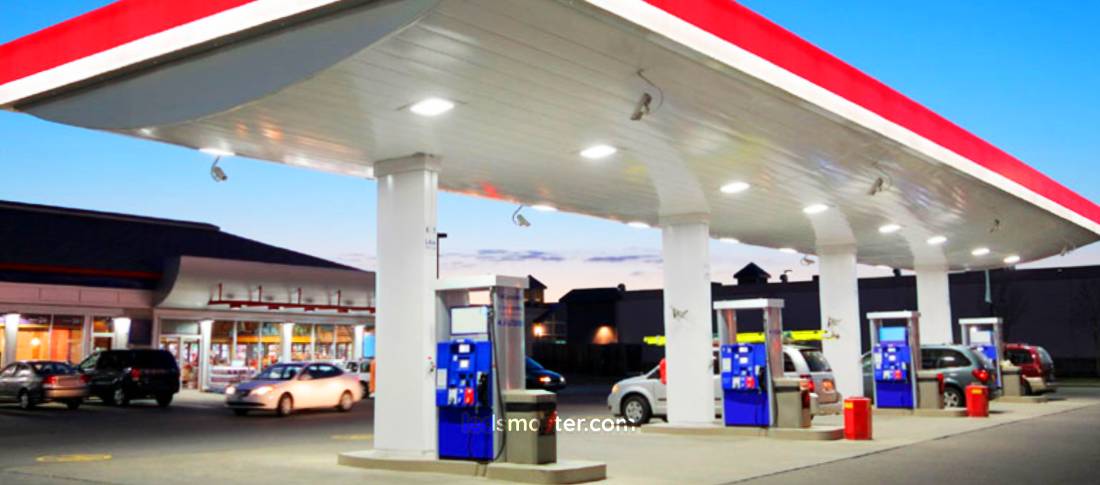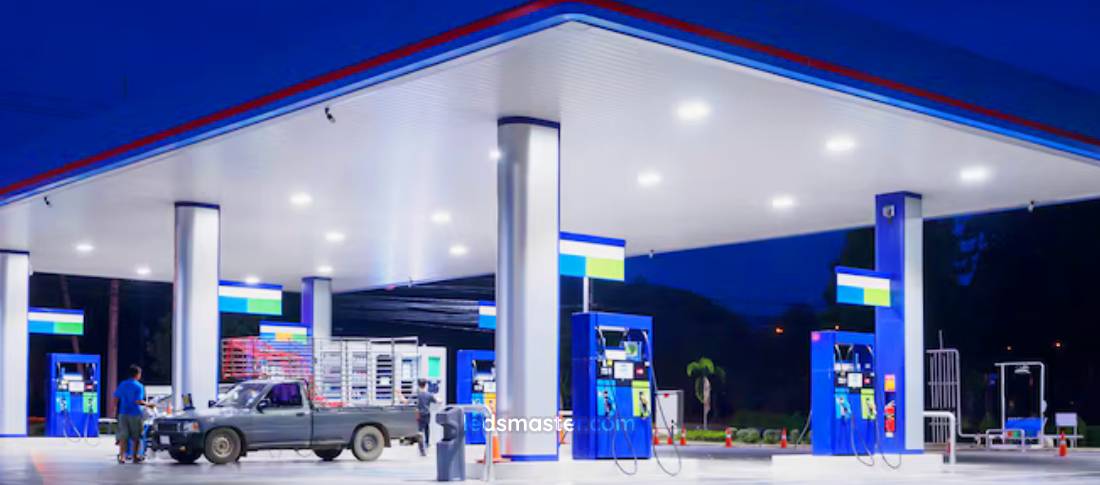Gas stations are integral to the infrastructure of modern life, offering fuel, convenience, and a place for travelers to stop and rest. However, like many other businesses, gas stations face rising operational costs and environmental challenges. One practical solution that addresses both of these issues is the adoption of solar-powered lighting. This shift not only helps gas stations save on energy costs but also contributes to sustainability, enhances customer experience, and boosts the business’s overall image.
Table of Contents
ToggleEnvironmental Benefits of Solar-Powered Lighting
The urgency to transition toward sustainable and environmentally-conscious practices has never been more pronounced. In recent years, the global community has witnessed a growing awareness of the environmental damage caused by over-reliance on fossil fuels. As industries and businesses explore methods to minimize their environmental footprints, renewable energy solutions such as solar power have gained significant traction. One area where solar energy can make a considerable impact is in the lighting systems of gas stations. By opting for solar-powered lighting, gas stations can contribute significantly to reducing their environmental impact while benefiting from a range of long-term advantages.
Reducing Carbon Footprint
A primary motivator for adopting solar-powered lighting at gas stations is the potential to reduce their carbon footprint. Gas stations, like many other businesses, rely heavily on electricity to power their lighting systems. Since many of these stations operate around the clock, lighting becomes a significant part of their energy demand, especially during nighttime hours when the majority of energy is consumed. The source of this electricity is often the local grid, which is typically powered by a mix of fossil fuels, including coal and natural gas. These energy sources emit harmful greenhouse gases that contribute to global warming and climate change.
By shifting to solar-powered lighting, gas stations can drastically reduce their dependence on grid electricity and, in turn, lower the carbon emissions associated with their operations. Solar energy harnesses the power of the sun, which is a clean, renewable resource. This reduction in reliance on fossil fuels directly leads to fewer carbon emissions, making solar-powered lighting an effective tool in reducing the environmental impact of gas stations.
The long-term benefits of reducing carbon emissions from gas station operations extend beyond just the immediate impact of switching to solar power. By adopting renewable energy, gas stations also support global climate action efforts aimed at meeting ambitious carbon reduction targets. Over time, as more businesses adopt solar power, collective emissions reductions could play a vital role in achieving climate goals set by countries and regions worldwide.

Promoting Renewable Energy Usage
Solar power, in addition to being environmentally friendly, is one of the most accessible and sustainable forms of renewable energy. Unlike fossil fuels, solar energy is virtually inexhaustible and can be harnessed throughout the day in nearly every part of the world. The sun’s energy is free, abundant, and available for use every day, unlike coal, oil, or natural gas, which require mining, extraction, and significant transportation, all of which have their own environmental impacts.
Gas stations that invest in solar-powered lighting help promote the use of renewable energy in a practical and visible way. They not only benefit from the clean energy produced by solar panels but also play a role in encouraging others in the industry to make the transition. This aligns with global energy trends, where businesses are under increasing pressure to reduce their reliance on nonrenewable energy sources and to support efforts that drive clean energy solutions.
Solar-powered lighting also supports the broader goal of transitioning the global energy grid from fossil fuels to renewables. Every solar panel installed and every solar-powered light that shines on a gas station at night contributes to a larger movement toward a cleaner, more sustainable energy future. Gas stations that embrace this shift can proudly stand as examples of renewable energy adoption and serve as a source of inspiration for other businesses.
Economic Advantages of Solar-Powered Lighting
While environmental benefits often take center stage in discussions about renewable energy, the economic advantages of switching to solar-powered lighting are equally compelling. For gas stations, which are traditionally energy-intensive establishments, adopting solar power can lead to significant savings and a more financially sustainable future.
Reducing Electricity Costs
The immediate and most noticeable benefit of solar-powered lighting is the reduction in electricity costs. Gas stations generally face high electricity bills, particularly because lighting is required around the clock. The operational hours of these stations, often stretching into the late evening and early morning hours, increase energy demand and result in large utility bills for the business owners. These costs can add up quickly and significantly affect profitability.
By investing in solar-powered lighting systems, gas stations can generate their own energy from the sun, which drastically reduces or even eliminates their need to purchase electricity from the grid. Solar lights utilize photovoltaic (PV) panels to convert sunlight into electricity during the day, and the energy stored in batteries is used to power the lights during the night. This process makes the gas station less dependent on external energy sources and substantially reduces electricity-related expenses. Over time, the savings accumulated from lower utility bills can offset the initial installation costs of the solar system, making it a highly cost-effective solution.
Furthermore, the use of solar-powered lighting increases the predictability of energy costs. Gas station operators no longer need to worry about fluctuating electricity rates or unexpected increases in energy prices. This financial stability helps to improve long-term budgeting and financial planning.
Lower Maintenance Costs

The cost-saving benefits of solar-powered lighting go beyond just energy savings. Conventional lighting systems, especially those using traditional bulbs or fluorescent lights, often require frequent maintenance. Over time, bulbs burn out, wiring deteriorates, and other components need to be repaired or replaced. This results in ongoing maintenance costs, which can be particularly burdensome for gas stations operating 24/7.
In contrast, solar-powered lighting systems tend to be more durable and require significantly less maintenance. Solar panels have no moving parts and are built to withstand outdoor weather conditions, reducing the likelihood of malfunction. LED lights, commonly used in solar-powered systems, have a longer lifespan than traditional lighting, further lowering maintenance costs. With fewer components subject to wear and tear, the need for repairs or replacements is minimal, making solar-powered lighting an attractive and reliable long-term investment.
Potential for Financial Incentives
In addition to reducing energy and maintenance costs, gas stations may also benefit from various financial incentives offered by governments and local authorities. Many regions have implemented programs that encourage businesses to invest in renewable energy solutions, such as tax credits, rebates, and grants. These financial incentives are designed to lower the upfront costs of installing solar-powered lighting and to make the transition to renewable energy more accessible for small and medium-sized businesses.
By taking advantage of these incentives, gas stations can significantly reduce the initial financial burden of adopting solar-powered lighting. This, in turn, makes the switch to solar power even more cost-effective and accelerates the return on investment. Financial incentives also contribute to the broader effort of promoting renewable energy and can help gas stations that may be hesitant to invest in solar power overcome initial cost concerns.
Building a Stronger Brand Image
As society becomes more attuned to environmental issues, consumers are increasingly looking at the values of the businesses they support. The idea of “voting with your wallet” has gained traction in recent years, and consumers are more likely to patronize companies that share their concerns about sustainability and the planet. Gas stations are no exception to this trend, and the decision to adopt eco-friendly practices, such as solar-powered lighting, can significantly shape the public perception of a business. In fact, investing in solar-powered lighting may offer gas stations a unique opportunity to strengthen their brand image, attract new customers, and build a loyal following.
Aligning with Sustainability Goals
Many businesses today are under increasing pressure to demonstrate their commitment to sustainability and social responsibility. Sustainability is no longer just a buzzword; it is becoming a core element of a company’s identity. Consumers are more aware of the environmental impact of the companies they engage with, and their purchasing decisions are often influenced by how well a business aligns with sustainable practices.
For gas stations, this means adopting initiatives that help reduce their environmental footprint. Installing solar-powered lighting systems can be an excellent way to achieve this goal. It shows consumers that the business is taking tangible steps to lower its carbon footprint and embrace clean, renewable energy sources. A commitment to sustainability is not just about making green claims; it is about backing up those claims with concrete actions. Solar-powered lighting serves as a visible and impactful example of a gas station’s dedication to reducing its reliance on fossil fuels and supporting the shift toward renewable energy.
This alignment with sustainability goals can set a gas station apart from its competitors. In a crowded market where consumers have many options, those that prioritize sustainability will stand out. Whether it’s by reducing carbon emissions, lowering energy consumption, or cutting down on waste, these actions can have a meaningful effect on a gas station’s reputation. Over time, customers will recognize the station as one that aligns with their own values, which could lead to increased loyalty and repeat business.
Appealing to Eco-Conscious Customers
One of the most significant ways solar-powered lighting can bolster a gas station’s brand image is by appealing to eco-conscious customers. As more people become aware of environmental issues, they are actively seeking out businesses that reflect their values and make efforts to protect the planet. Solar power represents one of the most accessible and visible forms of renewable energy, and consumers are increasingly drawn to companies that incorporate this technology into their operations.
Gas stations that embrace solar-powered lighting may attract drivers who are specifically looking to support businesses that are making strides toward sustainability. These eco-conscious customers may be willing to choose a gas station with solar-powered lighting over a competitor that does not prioritize such efforts, even if it means a slightly higher price or a less convenient location. By meeting the demands of these consumers, gas stations not only build a stronger customer base but also create an environment where customers feel good about their decision to support the business.
Moreover, a gas station that advertises its use of solar-powered lighting can greatly enhance its appeal. Marketing campaigns that highlight the station’s investment in renewable energy can draw in customers who are motivated by environmental concerns. With more consumers seeking businesses that support clean energy, a gas station’s commitment to sustainability can become a powerful selling point. Solar-powered lighting becomes a part of the station’s identity, one that communicates a strong message about environmental stewardship and corporate responsibility.
Building Consumer Trust
In today’s market, transparency is a key component of a successful brand. Consumers are no longer satisfied with companies that make vague or unsubstantiated claims about their sustainability efforts. To build and maintain trust, businesses must be transparent about their initiatives and demonstrate how they are contributing to the greater good. By investing in solar-powered lighting, gas stations can provide customers with tangible proof of their commitment to sustainability.
Trust is not just about making claims; it’s about following through on promises and creating an experience that aligns with those values. Gas stations that use solar-powered lighting are demonstrating their willingness to invest in long-term solutions that benefit both their business and the environment. This not only builds consumer trust but also fosters a sense of pride among employees, who are more likely to feel positively about working for a company that takes environmental responsibility seriously.
Positioning the Gas Station as a Leader in Sustainability
Investing in solar-powered lighting can also position a gas station as a leader in sustainability within its industry. Gas stations often operate in highly competitive markets, and companies are constantly looking for ways to differentiate themselves. Being an early adopter of renewable energy technology, such as solar lighting, can help a gas station gain a competitive edge over other stations that have not yet made similar commitments.
This leadership in sustainability can also translate into positive media coverage and recognition from environmental organizations. Gas stations that take bold steps to reduce their environmental impact may find themselves featured in local news stories, industry reports, or even award nominations for their green initiatives. This kind of recognition can help raise the station’s profile, attract new customers, and reinforce its reputation as an environmentally responsible business.
Overcoming Challenges in Solar-Powered Lighting Adoption
While the advantages of solar-powered lighting for gas stations are clear, it’s important to recognize that there are still some obstacles that businesses must overcome when considering this technology. Addressing these challenges head-on is essential for gas stations that are serious about transitioning to solar energy.

Initial Installation Costs
One of the most common concerns gas stations have when considering solar-powered lighting is the upfront cost of installation. Solar panels, inverters, battery storage systems, and other necessary equipment can require a significant initial investment. For many gas stations, this capital expenditure can feel like a substantial financial commitment, especially when compared to the relatively low costs of traditional lighting systems.
However, it’s essential to understand that the long-term savings associated with solar-powered lighting can more than compensate for these initial expenses. By reducing electricity costs and maintenance needs over time, gas stations can achieve a favorable return on investment. Additionally, government programs and financial incentives can help offset the upfront costs. Many local governments offer tax credits, rebates, and grants for businesses that adopt renewable energy technologies. These incentives can substantially reduce the financial burden of installing solar-powered lighting and make it a more viable option for gas stations with limited capital.
Space and Location Constraints
Another challenge gas stations may face when adopting solar-powered lighting is the availability of space for solar panel installation. Solar panels need to be placed in areas that receive adequate sunlight throughout the day to generate sufficient power. This may not always be possible, especially in urban areas or locations where the gas station is surrounded by tall buildings, trees, or other obstructions that block sunlight.
In such cases, gas stations may need to explore alternative solutions, such as installing solar panels on rooftops or other available spaces on the property. Some gas stations may also consider partnering with third-party solar energy providers to help offset the cost of installation and ensure that the panels are positioned optimally.
Additionally, before installing solar panels, it’s important to assess the structural integrity of the gas station’s buildings and roofs. The installation of solar panels may require modifications to the building’s infrastructure to support the additional weight and ensure that the panels are securely mounted.
Ensuring Energy Efficiency
To maximize the benefits of solar-powered lighting, gas stations should focus on ensuring that their systems are energy-efficient. Installing high-quality LED lights and using smart energy management systems can help ensure that the solar power generated is used effectively. Gas stations may also need to monitor the performance of their solar panels and lighting systems over time to ensure they continue to operate at peak efficiency.
While these challenges may seem daunting, they are far from insurmountable. By working with solar energy experts and taking the time to plan the installation carefully, gas stations can successfully adopt solar-powered lighting systems and enjoy the long-term environmental, economic, and branding benefits.
Conclusion
Solar-powered lighting offers gas stations a range of benefits, including reduced energy costs, lower carbon emissions, and improved operational efficiency. By adopting renewable energy, gas stations contribute to sustainability while strengthening their brand image and appealing to eco-conscious consumers. Despite challenges like initial costs and space constraints, the long-term savings and positive public perception make solar lighting a worthwhile investment. As the industry moves toward more sustainable practices, embracing solar-powered lighting positions gas stations to lead in both environmental responsibility and business growth, ensuring they remain competitive in a changing market.

